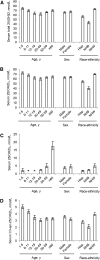National Estimates of Serum Total 25-Hydroxyvitamin D and Metabolite Concentrations Measured by Liquid Chromatography-Tandem Mass Spectrometry in the US Population during 2007-2010
- PMID: 27052537
- PMCID: PMC4841925
- DOI: 10.3945/jn.115.227728
National Estimates of Serum Total 25-Hydroxyvitamin D and Metabolite Concentrations Measured by Liquid Chromatography-Tandem Mass Spectrometry in the US Population during 2007-2010
Abstract
Background: The 2007-2010 NHANES provides the first US nationally representative serum 25-hydroxyvitamin D [25(OH)D] concentrations measured by standardized liquid chromatography-tandem mass spectrometry.
Objective: We describe patterns for total 25(OH)D and individual metabolites in persons aged ≥1 y stratified by race-ethnicity and grouped by demographic, intake, physiologic, and lifestyle variables.
Methods: We measured 25-hydroxycholecalciferol [25(OH)D3], 25-hydroxyergocalciferol [25(OH)D2], and C3-epimer of 25(OH)D3 [C3-epi-25(OH)D3] in serum samples (n = 15,652) from the 2007-2010 cross-sectional NHANES [total 25(OH)D = 25(OH)D3 + 25(OH)D2].
Results: Concentrations (median, detection rate) of 25(OH)D3 (63.6 nmol/L, 100%) and C3-epi-25(OH)D3 (3.40 nmol/L, 86%) were generally detectable; 25(OH)D2 was detectable in 19% of the population. Total 25(OH)D, 25(OH)D3, and C3-epi-25(OH)D3 displayed similar demographic patterns and were strongly correlated (Spearman's r > 0.70). Concentrations of 25(OH)D2 (90th percentile) were much higher in persons aged ≥60 y (17.3 nmol/L) than in younger age groups (≤4.88 nmol/L). We noted significant race-ethnicity differences in mean total 25(OH)D [non-Hispanic blacks (NHBs), Hispanics, and non-Hispanic whites (NHWs): 46.6, 57.2, and 75.2 nmol/L, respectively] and in the prevalence of total 25(OH)D <30 nmol/L overall (24% of NHBs, 6.4% of Hispanics, and 2.3% of NHWs) as well as stratified by season (winter months: 30% of NHBs, 7.5% of Hispanics, and 3.8% of NHWs; summer months: 17% of NHBs, 4.4% of Hispanics, and 1.6% of NHWs). Persons with higher vitamin D intakes (diet, supplements, or both) and those examined during May-October had significantly higher total 25(OH)D. Significant race-ethnicity interactions in a multiple linear regression model confirmed the necessity of providing race-ethnicity-specific estimates of total 25(OH)D.
Conclusions: Race-ethnicity differences in the prevalence of low total 25(OH)D remained strong even after adjustment for season to account for the NHANES design imbalance between season, latitude, and race-ethnicity. The strong correlation between C3-epi-25(OH)D3 and 25(OH)D3 may be because the epimer is a metabolite of 25(OH)D3. The presence of 25(OH)D2 mainly in older persons is likely a result of high-dose prescription vitamin D2.
Keywords: 25-hydroxyvitamin D2; 25-hydroxyvitamin D3; C3-epimer of 25-hydroxyvitamin D3; LC-MS/MS; NHANES.
© 2016 American Society for Nutrition.
Conflict of interest statement
Author disclosures: RL Schleicher, MR Sternberg, AC Looker, EA Yetley, DA Lacher, CT Sempos, CL Taylor, RA Durazo-Arvizu, KL Maw, M Chaudhary-Webb, CL Johnson, and CM Pfeiffer, no conflicts of interest.
Figures

References
-
- Hilger J, Friedel A, Herr R, Rausch T, Roos F, Wahl DA, Pierroz DD, Weber P, Hoffmann K. A systematic review of vitamin D status in populations worldwide. Br J Nutr 2014;111:23–45. - PubMed
-
- Cashman KD, Kiely M, Kinsella M, Durazo-Arvizu R, Tian L, Zhang Y, Lucey A, Flynn A, Gibney MJ, Vesper HW. Evaluation of vitamin D standardization program protocols for standardizing serum 25-hydroxyvitamin D data: a case study of the program’s potential for national nutrition and health surveys. Am J Clin Nutr 2013;97:1235–42. - PMC - PubMed
-
- Janz T, Pearson C. Vitamin D blood levels of Canadians. Statistics Canada. Catalog 82–624-X [cited 2015 Nov 20]. Available from: www.statcan.gc.ca.
-
- UK Food Standards Agency. National Diet and Nutrition Survey: results from years 1–4 (combined) of the Rolling Programme (2008–2009–2011/12): executive summary. London: Public Health England; 2014.
-
- LeFevre ML. Screening for vitamin D deficiency in adults: U.S. Preventive Services Task Force recommendation statement. Ann Intern Med 2015;162:133–40. - PubMed
MeSH terms
Substances
LinkOut - more resources
Full Text Sources
Other Literature Sources
Medical
Miscellaneous

